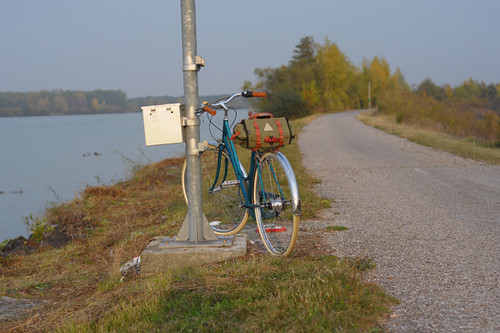
After more than two years of meaning to but never quite working up to it, I have finally completed my first "century" - a 100 mile ride. It didn't exactly happen as I had envisioned it, but it happened nonetheless. And it was certainly memorable.
The bike you see here is what I rode: It is a Bella Ciao Neorealista with a7-speed hub, front and rear caliper brakes, BrooksB17S saddle, 700Cx35mm Delta Cruiser tires, Berthoud fenders and MKS
touring pedals - lent to me by Citybiker in Vienna (thank you!). I decided to try the ride on this bicycle, because it seemed the safest bet of the available options - the others being borrowing a cool roadbike from Wolfgang, or riding Jacqueline. With the roadbike, it generally takes me a while to "dial in" the positioning, and I had no time to experiment. With Jacqueline, I was worried that she might be too heavy and too old for such a long ride. So I took advantage of being able to borrow the Bella Ciao, which seemed to be somewhere in between as far as positioning and also had the benefit of modern components. I felt that I knew what to expect with this bike, since I have a similar one at home and have ridden mine for 30 mile stretches at a time. We lowered the Neorealista handlebars for a more aggressive posture, but otherwise nothing was altered. I was not sure that I'd actually be able to do the ride, but the plan was to go as far as I felt comfortable.
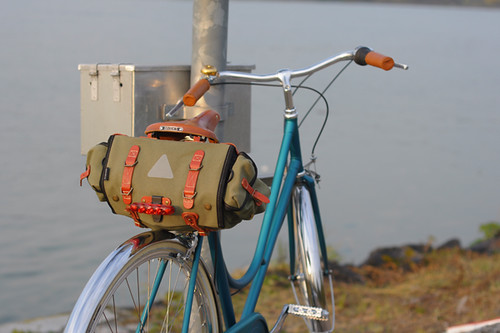
I had brought my Zimbale saddlebag from home and attached it to the bike before I set off. I have no pictures of myself during the course of this ride, but I was wearing pretty much this: wool tights, wool dress, 3/4 length wool overcoat, legwarmers, ankle boots with 2" heels, a hat, and (not pictured) gloves and a scarf. From the forecast I knew that the weather would be cold, mostly in the low 40s. In the event that I got too warm, I planned to take off my coat and attach it to the saddlebag with a bungee cord. In the event it got even colder, I packed an extra sweater. I also packed a pair of padded wool cycling shorts, in case my butt started to hurt on the way back. Aside from that, I packed battery-operated lights, a bottle of apple juice mixed with mineral water and salt, my camera, phone, bank card, cash, notebook, pen, and a packet of Ibuprofen
. I did not bother taking a map - since I would simply be following the Danube cycle path.
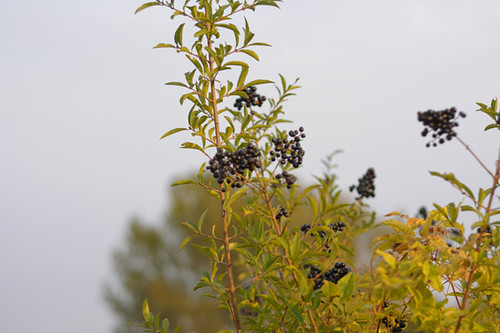
Before I go on, I must warn you that my photographic documentation of this ride is disappointing. I passed some gorgeous spots, but it wasn't practical to stop and take pictures if I hoped to maintain momentum. So all my photos were taken during food-break stops, which did not necessarily coincide with the scenic moments. I am also disappointed that I do not have a single photo of myself during this trip, as a memento - but I was too cold to mess with the self-timer, and my camera is difficult for strangers to operate.
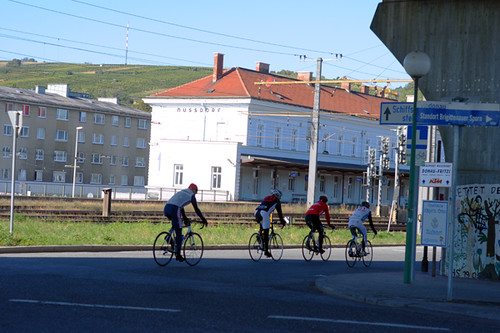
My trip did not begin according to plan. I had wanted to set off at 7:00 in the morning, but got delayed and was not able to leave until 10:00. With such a late start, I considered postponing to a different day - but my schedule was already full, so this was my only chance to do the ride. I went, making sure the batteries in my lights were fresh. The Danube Canal path is right around the corner from my flat, and within a minute of leaving the house I was on it. I sped through the urban part of the path, and within 15 minutes I reached the junction where the Danube Canal meets the Danube River proper.
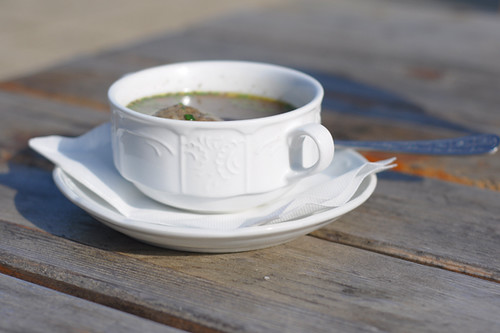
I rode without stopping past all of myfavourite spots in the countrysidealong the river and did not take a break until I approached the outskirts of Tulln - a town about 25 miles from the center of Vienna. Things were going well so far: It was cold, but sunny. I was only very slightly tired and nothing hurt or felt uncomfortable on the bike. It was around 12:00 noon, which meant I'd been cycling at 12.5mph on average for two hours straight. So far, so good.I stopped at a cafe with outdoor seating, and had a huge bowl of soup while looking at ships making their way along the river. The sunshine made everything look gorgeous.
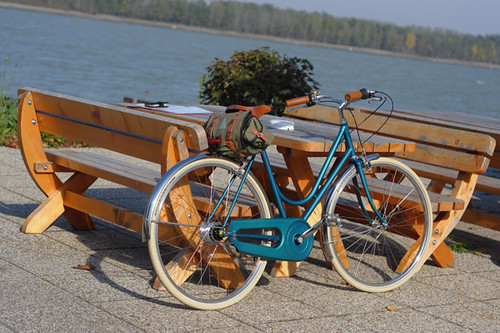
My plan was to continue on the Danube cycling path until I reached the town of Krems - a beautiful place in the Wachau valley. At this stage I was exactly half way. Unfortunately, this was the last time I would see nice weather during my ride.
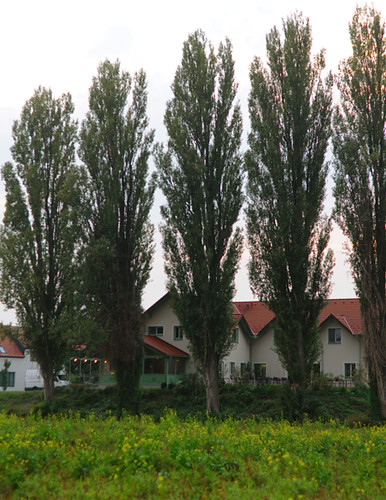
Almost as soon as I got going again, the sunlight faded and the temperature fell. The change was sudden: One minute, everything was bathed in a golden light, and the next the landscape was grim. I was finding it difficult to warm up, even though the mostly flat route meant that I was vigorously pedaling the entire time (no hills means not only no climbing, but also no coasting!) I kept hoping the sunshine would return, but it only got more overcast as I continued cycling.
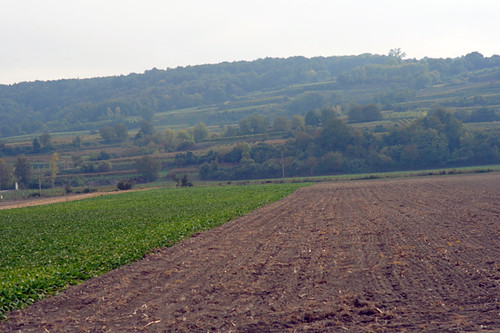
And then, things got worse: A milky fog descended over the valley. In the middle of the day! Just after Tulln, the Danube path veers away from the river for a few miles, cutting through woods and farmland. The landscape now looked washed out and dingy. Visually I did not mind it, and even found the idea of cycling all alone through fog and desolate fields romantic. But it was difficult to keep warm. The freezing fog was penetrating all my wool layers and getting into my very bones - a deep chill. And then the wind picked up. I pedaled harder and kept my head down.
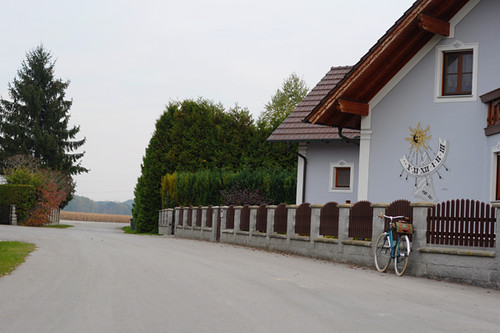
By 1pm, it became clear that the weather was not likely to improve. It was time for a change of plans: Krems was too good to see for the first time in such bleak light. Instead, I decided to go as far as Traismauer (a town 10 miles closer), and make up the missing miles by getting off the Danube path and doing a longer loop through some of the villages set back from the river. In doing so, I was also hoping to find a cafe that sold hot drinks, as all the ones along this portion of the Danube cycling path were closed for the season.
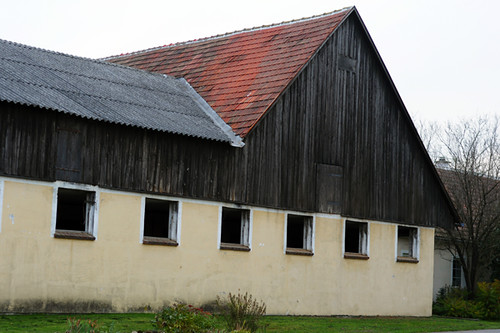
As far as navigation went, it was not difficult to make my way through the villages. There were signs everywhere announcing what the next village was and which direction to Traismauer. But it was extremely depressing. In good weather, I think the villages would have looked cute. But under overcast skies and enveloped in fog they looked abandoned and sinister. There were very few people out doing any kind of farm work and the few places of businesses that existed were all closed - even though it was a weekday.

I passed though the centers of five or six villages before I finally found one with a functional cafe - which was on the side of a sort of country highway leading to Traismauer. After I drank 3 cups of tea and rested a bit, I spoke to the waitress and learned that this was in fact the only road leading to Traismauer. Hitherto I had been cycling along small village streets, but this was a big road with an 80km/h speed limit. I decided to go ahead and brave it.
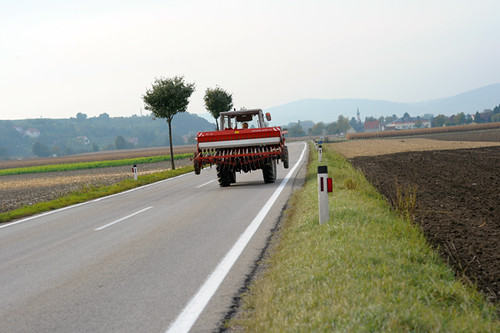
My companions during this stretch of the trip were mainly trucks and tractors. The trucks went very fast. The tractors went very slowly. The odd sportscar would occasionally zoom past as well. We all got along and I never felt endangered. My stamina, on the other hand, seemed to be nearly depleted and I had barely even cycled 60 miles. Please do not underestimate what I wrote earlier about a flat landscape meaning that you don't have the opportunity to coast. Pedaling the entire time, I was starting to feel like a mechanical doll. Traismauer was further away that I'd realised, and it felt as if I were cycling on the edge on that highway forever.
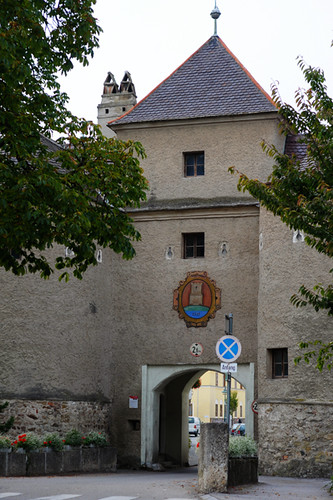
But finally, I was unmistakably there: This town was surrounded by a medieval wall and I cycled right through the gate.
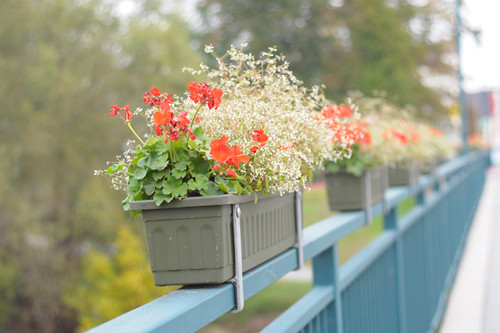
At one time there must also have been a moat. Now it was reduced to a sort of stream along the back part of the wall, with a modern bridge going across.
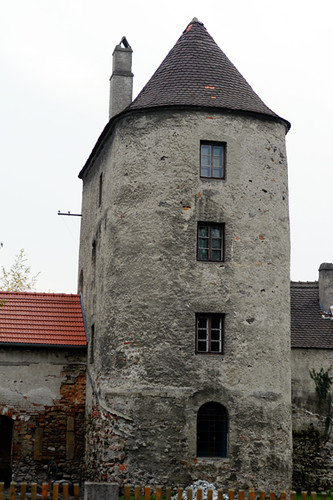
Under normal circumstances, I might have been excited by Traismauer. But now I just felt depleted. The cold weather, the fog, the lack of sunshine, the non-stop pedaling with the wind in my face - it had all beaten me down.
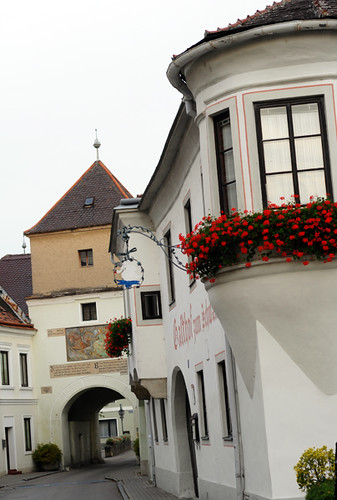
I circled around the town, then followed the signs to the train station. I am not proud of it, but yes - at this point I decided to cut my trip short and take the train back. It was already 3 pm and the most direct route home was over 40 miles. I didn't think I could handle it. At the station I learned that the next train to Vienna was not until 8:20pm, which was a long time to wait around. I decided to get something to eat while thinking about what to do next.

Turned out that I wasn't so much tired as just very hungry. Once I inhaled whatever it was that I bought at the food stand, my attitude suddenly improved and by 4pm I was ready to get back on the bike.

My plan now was to cycle the 15 miles back to Tulln - on the Danube cycling path and not through the villages this time - and see how I'd feel once I got there. The trains in Tulln ran more regularly, so if I was tired or did not want to continue in the dark, I would then take the train the rest of the way back.

Energised by the nutritional infusion, I pedaled enthusiastically for the next hour. Just as the light was fading, the sun started to come out and the fog dissipated - but it was late and I really wasn't able to stop and capture the beautiful scenery. There is a stretch at some point where the cycling path interrupts entirely, and cyclists must transition to the road for 2-3 miles. The route is signposted, but these signs are very small and have no provisions for being seen in the dark. The scenario I wanted to avoid, was cycling through this stretch once it had already gotten dark.
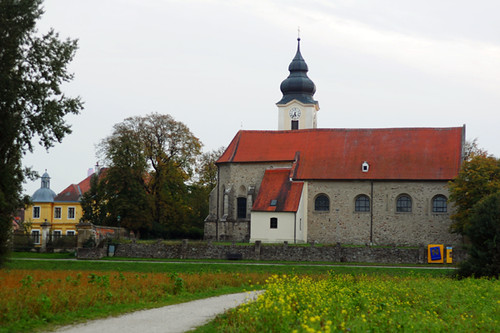
But of course, that is exactly what happened. I raced against the sunset, but despite my best efforts ended up cycling on the road with car traffic in rural darkness - squinting to find the signs instructing where to turn in order to get back onto the cycling path. It was just past 6pm now and there were lots of cars on the road - going quite fast, which was scary. I was starting to despair, when I noticed what was obviously another bicycle tail light in front of me. It was an elderly man, cycling with a sack of turnips strapped to his rear rack. I called out to him, asking if this was the right way to the cycle path. He replied that it was, and gestured for me to follow him. We "pacelined" for the next mile or so and then I followed him through an opening in the fields and we were on the Danube path. He then waved and turned around, and I realised that he'd gone out of his way only to show me how to get back on the path. I yelled "Danke vielmals!!" and waved wildly. This was my only interaction with another cyclist during the course of this ride.
Once in Tulln, I kept on going. It was already pitch black and my legs already felt as if someone else was controlling them, so it seemed I could just keep going this way. The last 20 miles of the trip felt like a trance. My headlight beam, the shadows of tree branches, the sounds of howling coming from the woods and the occasional lights of ships along the Danube felt like a dream. My wheels turned and turned and my feet pedaled and pedaled in as high as gear as I could manage. It wasn't a bad feeling, like an out of body experience. But I remember thinking "Hmm, I probably won't be able to walk tomorrow."
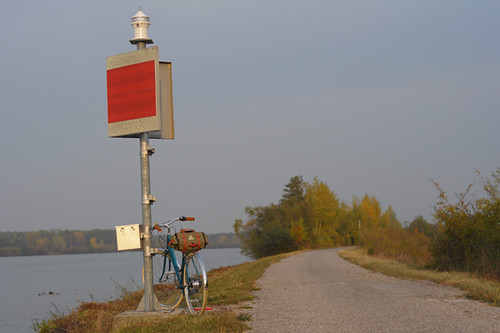
By the time my shaking hand retrieved the house key from my coat, it was almost exactly 8pm: 10 hours after I left. I had spent a total of an hour and a half taking breaks, which means that my average speed was 11.75 mph. I think that's not too bad for being on an upright bike and riding dressed as I was.I assumed that I would collapse upon coming home, but then a friend rang up and invited me for a drink. I went, and ended up staying out until midnight. The next morning I woke up at 8am and, to my astonishment, felt fine. I cycled around the city for transportation all day just as I normally do. There was hardly any evidence that I had ridden 100 miles the day before. My right shoulder was sore, and my sit bones were just a tad sensitive. However, there was no pain in my legs or knees, and I had plenty of energy. I expected to be wrecked, and this was almost anticlimactic.
This trip was not how I'd imagined completing my first "century." I was riding a city bike bundled up in an overcoat, the weather was horrible, and the countryside was at its bleakest. But I found the experience fulfilling, beyond just checking off a box. I relished the feel of being self-sufficient - not in the safety net of a group ride or a companion's presence, but alone in the middle of nowhere, amidst a stark landscape in a foreign country, and feeling as if I did not need to worry, because I was on a bike and could therefore do anything. It's what cycling is about for me. And I think I'm ready for a longer ride.
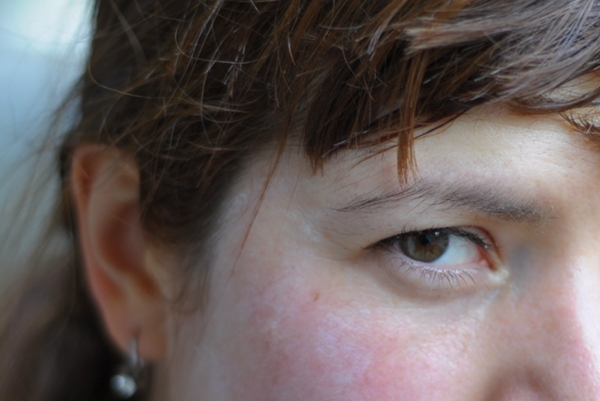 Though I have derived many benefits from cycling, the one drawback I am still struggling with is sun damage. During my first year on the bike as an adult, I thought that I was being pretty good about using sun protection, but noticed visible damage to my skin that seemed to be a direct result of cycling over the summer months. Darkened patches and wrinkles appeared in areas of my face and body that had been most exposed to the sun while cycling. And this was despite using high SPF sunblock and staying off the road during the hottest times of the day.
Though I have derived many benefits from cycling, the one drawback I am still struggling with is sun damage. During my first year on the bike as an adult, I thought that I was being pretty good about using sun protection, but noticed visible damage to my skin that seemed to be a direct result of cycling over the summer months. Darkened patches and wrinkles appeared in areas of my face and body that had been most exposed to the sun while cycling. And this was despite using high SPF sunblock and staying off the road during the hottest times of the day.










 I was quite confused about the agenda actually as it was a last-minute surprise, thus I ended up following the women to another location where the chocolate making session is held. Had I known about the beer tasting option, I would have changed course.
I was quite confused about the agenda actually as it was a last-minute surprise, thus I ended up following the women to another location where the chocolate making session is held. Had I known about the beer tasting option, I would have changed course.














 I don't know about you climbers,but the idea of pointing some welding rod thingy, that's seething with a high potential electric charge at a pipe that's pressurised with natural gas in the middle of a populated city,as a little spooky.
I don't know about you climbers,but the idea of pointing some welding rod thingy, that's seething with a high potential electric charge at a pipe that's pressurised with natural gas in the middle of a populated city,as a little spooky.




























